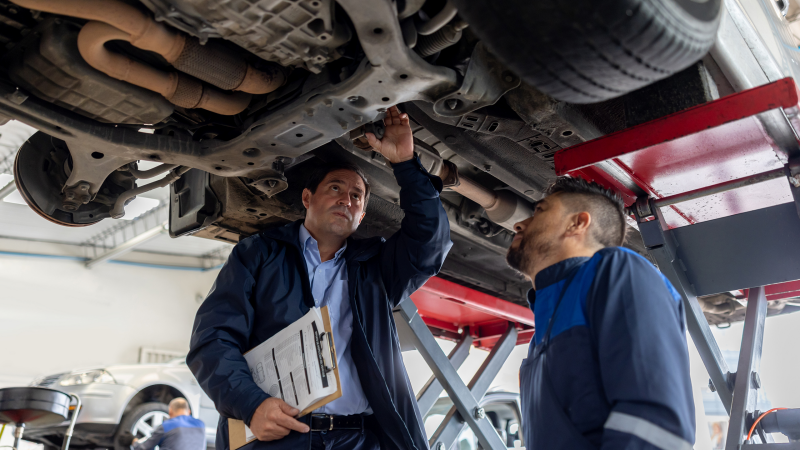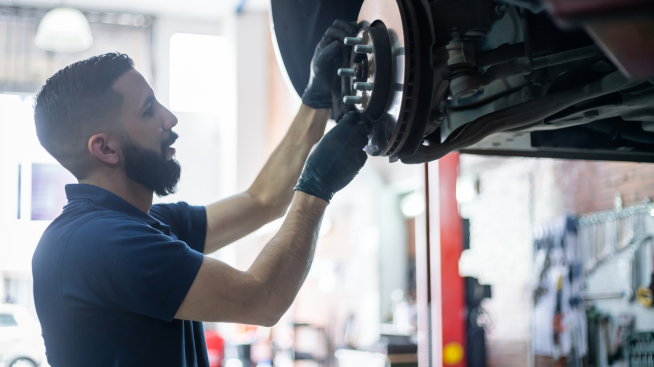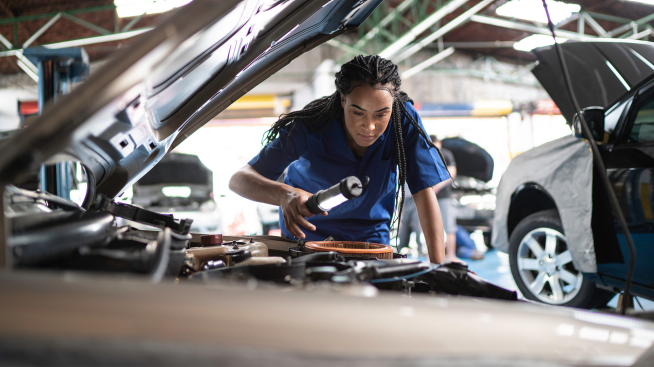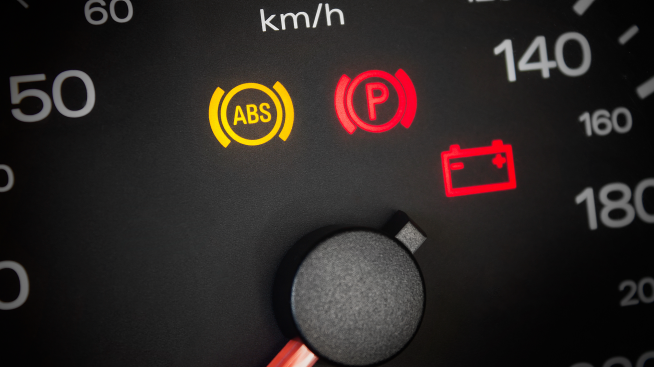Car suspension 101: What you need to know

When it comes to car design, how effectively your vehicle absorbs the shocks of the road is more than simply a matter of comfort — it’s a question of safety too. Without your car suspension helping to stabilize your vehicle while it’s in motion, driving would be a far more dangerous pursuit.
What is suspension on a car?
No road is perfectly flat, meaning that bumps are inevitable. Your vehicle’s suspension system disperses the energy from these jostles in such a way as to improve car safety and comfort.
At the mechanical level, your auto suspension system helps improve steering and braking. It is designed to optimize traction between your car tires and the road, for a smoother ride. Since it handles shocks that might otherwise weaken crucial components, a car’s suspension also helps extend the lifespan of your vehicle.
Parts of a suspension system
A car suspension system is part of your vehicle’s chassis, which comprises its load-bearing elements. This includes the wheels, parts of the steering and braking systems and the all-important suspension system. While setups may differ from manufacturer to manufacturer, suspension systems tend to share certain elements in common.
- Rods: A car’s suspension system contains multiple rods that connect its different parts. In “dependent systems,” wheels are rigidly connected to axles and turn at the same time, while in “independent systems,” the wheels can turn independently. Spanning the axles are sway bars, which, true to their name, reduce vehicle sway and help minimize roll as a car turns corners. Control arms connect the wheels to the car’s frame and enable vertical movement, while ball joints allow the control arms to pivot and move freely.
- Springs: Suspension systems have springs, which support the car’s weight. Importantly, springs also help absorb energy from road impact, reducing its transmission into the frame and passenger compartment. Coil springs are commonly used in passenger cars, while some heavy-duty vehicles rely on “leaf springs,” which consist of bound layers of metal that spring back after bending.
- Dampers: Springs, by definition, are bouncy. When energy moves into them, they’re designed to spring back out. This is where dampers come in. Dampers, or shock absorbers, use hydraulic fluid to create resistance against the motion of the spring. The fluid resistance converts kinetic energy into heat, which is dissipated into the air. Struts, which are often associated with dampers, are a combination of your shocks and another component, typically a coil spring that goes around the shock.
How does car suspension work?
The workings of a car suspension system rest on the first law of thermodynamics: Energy is neither created nor destroyed. This means that energy generated from driving over a bump or dip in a road needs to go somewhere.
Your car suspension works by performing the following functions:
- Distributing energy: The auto suspension system helps to manage the energy that travels into your car through the tires. Dampers, such as shocks and struts, help convert some of this energy into heat.
- Maintaining tire contact: If upward kinetic energy from a bump lifts your car, that reduces friction between your tires and the road as less of the surface area of the tire’s rubber is in contact with the pavement. It can even lift your vehicle off the ground, potentially damaging it as the wheels drop back to earth. Suspension systems are designed to help maintain contact between your tires and the road by helping absorb the energy associated with bumps and reducing the risk of bouncing.
- Stabilizing the vehicle: Car suspension systems play an important role in stabilizing your vehicle. While you want to avoid bumps and jostles, you also want to avoid the car “diving,” “squatting” or swaying. “Diving” is when your car dips forward when braking, and “squatting” is when your car tips backward when accelerating. Suspension systems help reduce the dive and squat to safe levels. They also minimize “roll” while the vehicle turns corners, preventing it from overly swaying to one side. Sway bars, also known as anti-roll bars, help keep your car level and your tires in contact with the road when cornering.
- Increasing comfort: If your car didn’t have a suspension system, more energy would travel into the vehicle frame and passenger compartment every time you drive over a stone or crack in the road. The jostling would probably make your ride extremely uncomfortable. It could also damage your vehicle.
Car suspension maintenance tips
As we have seen, suspension systems are crucial for the proper functioning of your vehicle. Like any critical system, it’s generally best practice to undertake any routine maintenance that may affect its smooth operation, and that includes your tires.
Tire maintenance
Your tires’ ability to maintain steady contact with the road surface is vital to a fully functioning suspension. Types of tire maintenance to consider include:
- Inspecting tire treads: If your treads are at the appropriate depth, this will help ensure that your car maintains adequate traction and handling. Worn treads reduce your vehicle’s grip on the road, which can strain your suspension as it struggles to keep everything stabilized.
- Checking tire pressure: Keeping your tires inflated to the level specified by your manufacturer in your owner’s manual not only helps minimize tire wear but can help support your car’s suspension. This is because tire pressure affects the size of your tire's contact patch with the ground. Overinflation leads to a smaller contact area, which tends to create less traction with the road and may force your car’s suspension system to work harder. Underinflation, by contrast, leads to a larger contact area between the tire’s rubber and the road, which may increase wear on the suspension by ramping up friction. Either way, by not maintaining the correct level of inflation in your tires you run the risk of putting your suspension system under unnecessary pressure.
- Realigning tires: The way in which your wheels form an angle with the vehicle is known as tire alignment. If your wheels tilt too much in any direction, there’s the risk of insufficient contact between your tires and the road. Misalignment is not only bad for your tire tread, but it can potentially result in a loss of traction. Keeping your wheels properly aligned helps your auto suspension to do its job.
Other maintenance areas to consider include:
Power steering belt and fluid
Having a trusted mechanic examine your power steering belt to make sure it’s tight, and to replace or top off fluid levels as necessary, can help your auto suspension by keeping your power steering system in good shape.
System inspection
Much of your car’s suspension system includes complex components that you may want to have checked periodically by your mechanic. You might also consider taking your car into the shop if you have reason to believe that your auto suspension system isn’t functioning properly.
Signs of a problem may include your vehicle dipping or bouncing upon braking, feeling shakier than usual or seeming lower to the ground. Other potential signs may include fluid leaks, uneven tire tread and unusual noises as you drive.
In summary
Without a suspension system, your car would jostle, sway, dip and possibly even lose contact with the road. By managing the way in which energy from bumps, brakes and turns is distributed throughout the vehicle, your suspension system allows for improved handling and a smoother ride. Given the importance of your car suspension, it’s typically a good idea to get it regularly inspected by a professional. That way, you can ensure its proper functioning and get ahead of any potential wear and tear.



